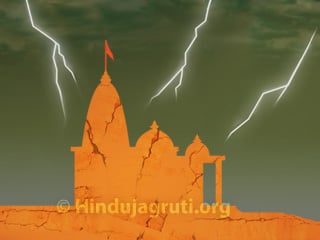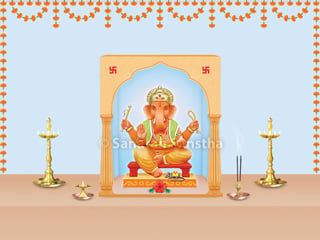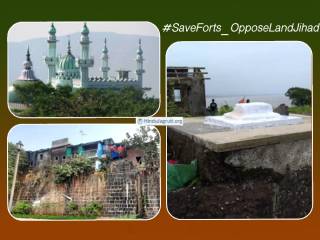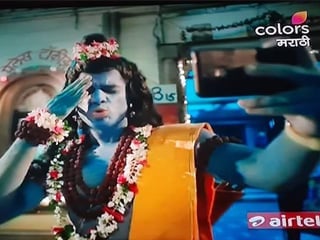Index
- 1. Definition
- 2. What do our scriptures say about shuddhikaran?
- 3. Various methods of purification and rituals
- 4. Paths of spiritual practice for those who have converted to Hindu Dharma
- 5. Doubts on purification as clarified by Swami Vivekanand
- 6. Appeal to the Hindu Society
1. Definition
Process of reconverting those who had converted to another religion because of deceit, force or threat to life, to the original religion is known as ‘shuddhikaran’.
2. What do our scriptures say about shuddhikaran?
Renouncing your own Dharma and embracing another is considered a sin in Hindu Dharma. Our scriptures are particular about purity of conduct, and hence, the Hindu society maintains a distance from converts or Hindus who mix excessively with people of other religions in various ways for long periods. Nevertheless, ‘if a Hindu happens to embrace another religion, then the doors of Hindu Dharma are forever shut for him’ – this is not what the authors of scriptures have said. On the contrary, they have stated the provisions available to release oneself from great sins by taking appropriate atonement.
2.1 Atharvaveda (One of the four most sacred Hindu scriptures)
This Holy text clearly mentions how our ancient Vedic ancestors performed the ritual of ‘vratyastom sanskar’ and accepted the non-Vedics into their fold with honour. This proves that, purification can be done by ‘vratyastom sanskar’.
2.2 Manusmruti (A Hindu Holy text written by Sage Manu)
In Manusmruti (Manu 8.168), Sage Manu has said that what is imposed, forced in an unjust manner, written under duress – these are all ‘akrut’, meaning, have not taken place at all. This means that the demerit incurred by conversions, in these ways, can be alleviated with an act of atonement. Manu’s promise in this context is –
अकामतः कृतं पापं वेदाभ्यासेन शुध्यति ।
कामतस्तु कृतं मोहात् प्रायश्चितैः पृथग्विधैः ।।
– Manusmruti, Adhyaya 11, Shloka 45
Meaning: Any demerit incurred due to an act committed without greed or avarice can be cleansed with study of the Vedas (The most sacred Hindu scriptures regarded as revealed directly by God), while that incurred due to acts performed with greed or avarice can be cleansed by taking various kinds of atonements. (The individual then gets purified.)
2.3 Yadnyavalkyasmruti
Along with a list of grave sins, this Holy text has a list of 39 minor sins. Renouncing your own religion is the 34th minor sin in this list. To get liberated from the demerit incurred by this minor sin, Yadnyavalkya has recommended acts of atonement –
उपपातकशुद्धिः स्यादेवं चान्द्रायणेन वा ।
पयसा वापि मासेन पराकेणाथ वा पुनः ।।
– Yadnyavalkyasmruti, Adhyaya 3, Shloka 265
Meaning : Purification from the demerit incurred from a minor sin takes place by performing Chandrayan vrat for one month, living only on milk for a month or by undertaking Parak atonement (Fasting for 12 days and nights and keeping the mind attentive and organs subdued).
2.4 Devalsmruti
In the year 732, Mohammad bin Qasim attacked Bharat and converted Hindus in Sindh and Kashmir. That was the first instance when the question of purification of converted Hindus arose. Maharshi Deval, a Saint from Gujarat wrote the Devalsmruti to purify the Dharmabhrashta (Polluted from the perspective of Dharma). All kinds of contaminations caused due to intermixing (physical, social, intellectual, religious etc.) with people of other religions have been described and appropriate atonements to be taken for each of them have been listed in this Holy text. (Devalsmruti, Adhyaya 7, Shloka 23)
In the purification process, the biggest problem was that of a woman who was raped. In this context, Devalsmruti clearly states that a girl or woman who has been raped becomes as pure as before after she gets her next menstrual period.
2.5 Parasharsmruti, Bruhaspatismruti and Yamasmruti
It was a belief in the middle ages that a man gets converted to another religion by eating food (bread etc.) prepared by a Muslim or Christian. However, Parasharsmruti, Bruhaspatismruti and Yamasmruti have shown that there are ways to get out of even greater sins such as eating beef.
2.6 Not purifying those interested in getting themselves purified is also a sin as per the scriptures
The authors of scriptures have said in no uncertain words that those who refuse to purify an individual who begs that, ‘prescribe atonement to me and thereby purify me’ are equally party to the sin.
3. Various methods of purification and rituals
3.1 Performing sanskars of purification with dung and urine of cow
Muslim historian Al-Biruni has mentioned that Hindus converted to Islam by invaders in the Year 1000, were purified by the Brahmans in those days by bathing them with dung and urine of cows, and then accepted into the Hindu religion’.
3.2 Method of purification adopted by H.H. Karapatraswami
‘To purify Hindus who were converted to another religion, H.H. Karapatraswami asked them to recite the Vishnusahastranam, read the 12th Adhyaya of Shrimadbhagwadgita and to perform Trayodashakshari japa of Deity Shriram. With this preaching, He would bless them with tulsi (Holy basil) leaves and tirtha (Sacred liquid). In this way, Hindus performing spiritual practice were included in Hindu Dharma.’ – Gurudev Dr. Kateswamiji
(Purification takes place only with the sattvikta [Purity] or resolve of a highly evolved Saint. Whatever remedies they advise in the form of Karmakanda (Path of ritualistic worship) are a mere formality. – Compilers)
3.3 Shuddisanskar (Ritual of purification) as prescribed by the scriptures
‘The religious ritual recommended by the scriptures to purify Dharmabhrashta Hindus and bring them back into the fold of Hindu Dharma is termed as shuddisanskar. This shuddisanskar is a kind of atonement. Step by step it includes :
1. Prayashcittakathan (Reading out the atonement),
2. Achaman (Sipping water from the right palm after pronouncing 24 Names of Shrivishnu)
3. Sankalp (Resolve),
4. Kshour (Tonsuring),
5. Panchagavyaprashan (Partaking of a mixture of milk, ghee, curds, urine and dung of cow),
6. Dandapradan (Allotment of atonement) – this includes Kruchratraya atonement. If it is not possible to take this atonement, then wealth should be donated to a Brahman as is possible depending on one’s ability,
7. Jalabhimantran (Charging the water with mantras and sprinkling or bathing with it),
8. Mahabhishek – in which abhishek (Consecration with water) is performed amidst recitation of a mantra that means ‘May all the Deities, planets, Sages, cows, trees, serpents, demons, Apsaras (Celestial beauties), rivers, Holy places of pilgrimage perform abhishek on you’,
9. Tilakdharan (A vertical mark made on the forehead with substances such as kumkum),
10. Puja (Ritualistic worship) of the Ishtadevata (Benevolent Deity),
11. Namakaran (Naming ceremony),
12. Abhivadan – Obeisance to Parameshwar (Supreme God),
13. Tirthaprashan (Partaking of tirtha),
14. Mantropadesh (Preaching of a mantra) as per the need,
15. Punarupanayan (Performing upanayan sanskar once again) and hom (Fire sacrifice).
This ritual is easy to perform and has been agreed upon by the authorities on scriptures. This ritual does not require a very learned priest. It is easy and can be performed by anyone.’ – MM Siddheshwarshastri Chitrav (Shuddhisanskar, 1927)
4. Paths of spiritual practice for those who have converted to Hindu Dharma
A. According to Bhagwapuran, Dharmabhrashta individuals are purified when they chant the Name of Shrivishnu.
B. ‘People who embrace Hindu Dharma after conversions will belong to the Vaishnav sect. The Bhaktimarg (Path of Devotion) recommended by the Bhagwat is for these people. It will make the Hindu society progress, radiant and opulent.’ – Gurudev Dr. Kateswamiji
5. Doubts on purification as clarified by Swami Vivekanand
In 1899, the periodical ‘Prabuddha Bharat’ interviewed Swami Vivekanand on the subject of ‘Purification of converted Hindus and those who are originally non-Hindus’. Summary of the doubts clarified by Swami Vivekanand is given ahead.
5.1 Necessity of purifying Hindus who had converted to another religion
Representative : Should Hindus who had converted (to another religion) be accepted by the Hindu Dharma after purification ?
Swami Vivekanand : ‘Without doubt. Hindus who had converted to another religion should be purified. If that is not done then gradually the Hindu population will dwindle. The ancient Muslim historian Ferishta says, when Muslims first came to this country the Hindu population was 60 crores. Today (in 1899) it is only 20 crores. Most of the conversions have been done forcefully by Muslims and Christians at sword point. Most present day members of other religions are the descendants of Hindus who were converted in that period. It is not at all beneficial to drive them away. If people, who had converted to another religion of their own accord, now wish to return to their original religion, then they too should be purified. Hindus who were compelled to embrace another religion because of atrocities inflicted upon them do not need to perform any act of atonement to return to the Hindu Dharma.
5.2 History reveals that non-Hindus were welcomed by Hindu Dharma
Representative : Is there a need to purify non-Hindus, that is, convert them to the Hindu Dharma ?
Swami Vivekanand : In the past, many people of foreign origin have been accepted by Hindu Dharma. Many ethnic groups living in forests on the borders of the country have been accepted by Hindu Dharma. Such people of foreign origin need not take atonement when entering the Hindu Dharma.
5.3 After purification, Hindus who have converted to another religion should accept their original caste
Representative : What should be the caste of the purifi ed individuals ?
Swami Vivekanand : Those who were converted to another religion forcibly will return to their original caste. An entirely new caste will have to be created for new entrants to Hindu Dharma. This caste will be the Vaishnav caste. To avoid varnasankar (Intermixing of varnas), they should marry in their own caste. They should have Hindu names because these names have both, a Hindu identity and Chaitanya (Divine consciousness). – ‘Prabuddha Bharat’ (April 1899)
6. Appeal to the Hindu Society
A. To keep the Hindu society alive, start a purification campaign ! : ‘Some people ask arrogantly, ‘What will you gain by purification of an individual or a few hundred people ?’ Just as a lake is formed out of a collection of many droplets of water, so does it dry up when the droplets evaporate’. Proactive Hindus should take cognisance of this fact. In this context, founder of the ‘Bhosale Army School’ in Nashik and a radiant Hindu leader (Late) Dr. Balakrushna Shivaram Munje would say, ‘If we wish that Hindu society continue to exist with all its radiance, then a purification campaign should be commenced’. – Mr. Sanjay Mulye, Ratnagiri (
B. Purification of converts should be on the agenda of Hindus ! : ‘After slaying Tipu Sultan, the army of the Marathas along with the British army was returning to Pune. On the way, many Hindu families were standing on the road sides pleading, ‘Please make us Hindus again’ to the Maratha army commander Haripant Phadke. They wished to return to the Hindu Dharma, but the subject of purification of converted Hindus was not on the agenda of Marathas. Even today, Hindus do not include on their agenda purification of converted Hindus. Excluding a negligible period of Deval Maharshi, Chhatrapati Shivaji Maharaj, Swatantryaveer Savarkar, H.H. Masurkar Maharaj and Swami Shraddhanand, history reveals that the Hindus have neglected purification of converts completely. Swatantryaveer Savarkar had warned that ‘purification was not just a religious task, it was also political’. Hence, purification should necessarily be a part of Hindu agenda.’ – Mr. Arvind Vitthal Kulkarni (Monthly ‘Lokjagar’, 2008)
C. The campaign to purify Hindus who have converted to other religions in Bharat should gain momentum ! : ‘H.H. Masurkar Maharaj had said, ‘Today, the mission of reconverting the descendants of Hindus who had been converted to another religion, and granting them religious freedom is the most sacred mission, even more sacred than a pilgrimage to Kashi’. This sacred mission should be performed not only in converted tribal areas, but in every non-Hindu area. You cannot become a Muslim without circumcision or a Christian without baptism. In the same way, without purification, converts cannot become Hindus. That is precisely why the campaign to purify Hindus who have converted to other religions in Bharat should gain momentum. Conversions of Hindus are even more frightening than desecration of temples. Razed temples can be reconstructed, but people who have gone to another religion do not return. Rather, later, their descendants become staunch anti-Hindus and desecrate the new temples. To stop this cycle of cruelty, every Hindu should take upon himself the task of reconverting these converted Hindus to Hindu Dharma. As advised by Samartha Ramdas Swami, Hindus need to blow the conch of purification all over Bharat to protect Hindu Dharma.
For purification, please contact the following centres
1. Mumbai
Masurashram, Masurashram Marg, Goregaon (East) Mumbai 400 063.
Phone no : (022) 28741997
2. Pune
A. Vishwa Hindu Parishad, State Offi ce, 1360, Shukrawar Peth, Pune 411 002.
Phone No. : (022) 24471701, Mobile No. : 9422466757
B. Mr. MK Deshpande, Pune Dharmajagran Trust.
Mobile No. : 9890623254
C. Arya Samaj, Pimpri, Pune.
Phone No : (020) 27274813
3. Jalgaon
Mr. Vamanrao Sakhare, Dharma Jagaran Sanstha, Jalgaon.
Mobile No. : 9421639827
4. Bengaluru, Karnataka
Karnataka Arya Pratinidhi Sabha, Vishveshvarampur, Shraddhanand Bhavan Marg, Bengaluru
Phone No. : (080) 26626380
(Reference – ‘Religious conversions and Purifying the converted’ )

 Free Hindu Temples
Free Hindu Temples Anti-Ganeshotsav Propaganda
Anti-Ganeshotsav Propaganda Love Jihad - A fate worse than death !
Love Jihad - A fate worse than death ! Religious conversion
Religious conversion Save Forts : Pitiable state oprized heritage of Hindus
Save Forts : Pitiable state oprized heritage of Hindus Hinduphobia
Hinduphobia
good article. A question for you. Which verse from Rig Ved will be a good mantra fro declaration of faith?